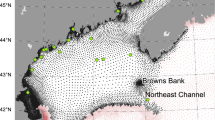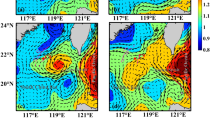Abstract
Past studies suggested that a basin-wide regime shift occurred in 1988–1989, impacting marine ecosystem and fish assemblages in the western North Pacific. However, the detailed mechanisms involved in this phenomenon are still yet unclear. In the Ulleung basin of the East Sea, filefish, anchovy and sardine dominated the commercial fish catches in 1986–1992, but thereafter common squid comprised > 60% of the total catch in 1993–2010. To illuminate the mechanisms causing this dramatic shift in dominant fisheries species, I related changes in depth-specific oceanographic conditions from 0 to 500 m to inter-annual changes in the fish assemblage structure from 1986 to 2010. In the upper layer of 50–100 m depths, water temperature suddenly increased in 1987–1989, and consequently warm-water epi-pelagic species (anchovy, chub mackerel, and common squid) became dominant, while sardine, relatively cold-water epi-pelagic species, nearly disappeared. An annual index of the volume transport by the Korea Strait Bottom Cold Water, originating from the deep water of the Ulleung Basin, displayed a sudden intensification in 1992–1993, accompanied by decreased water temperature and increased water density in the deep water and replacement of dominant bentho-pelagic species from filefish, warm-water species, to herring and cod, cold-water species. The results suggest that climate-driven oceanic changes and the subsequent ecological impacts can occur asynchronously, often with time lags of several years, between the upper and the deep layer, and between epi-pelagic and deepwater fish assemblages.
Similar content being viewed by others
References
Chang KI, Teague WJ, Lyu SJ, Perkins HT, Lee DK, Watts DR, Kim YB, Mitchell DA, Lee CM, Kim K (2004) Circulation and currents in the southwestern East/Japan Sea: overview and review. Prog Oceanogr 61:105–156
Chiba S, Aita MN, Tadokoro K, Saino T, Sugisaki H, Nakata K (2008) From climate regime shifts to lower-trophic level phenology: synthesis of recent progress in retrospective studies of the western North Pacific. Prog Oceanogr 77:112–126
Cho Y-K, Kim K (1998) Structure of the Korea Strait Bottom Cold Water and its seasonal variation in 1991. Cont Shelf Res 18: 791–804
Choi K, Lee CI, Hwang K, Kim S-W, Park J-H, Gong Y (2008) Distribution and migration of Japanese common squid, Todarodes pacificus, in the southwestern part of the East (Japan) Sea. Fish Res 91:281–290
Cressie NAC (1993) Statistics for spatial data, Revised edn. Wiley-Interscience publication, New York, 900 p
Hill MO (1973) Reciprocal averaging: an eigenvector method of ordination. J Ecol 61:237–249
Hill MO (1974) Correspondence analysis: a neglected multivariate method. Appl Stat 23:340–354
Huse I, Korneliussen R (2000) Diel variation in acoustic density measurements of overwintering herring (Clupea harengus L.). ICES J Mar Sci 57:903–910
Hwang K, Jung S (2012) Decadal changes in fish assemblages in waters near the Ieodo ocean research station (East China Sea) in relation to climate change from 1984 to 2010. Ocean Sci J 47:83–94
Hyun J-H, Kim D, Shin C-W, Noh J-H, Yang E-J, Mok J-S, Kim S-H, Kim H-C, Yoo S (2008) Enhanced phytoplankton and bacterioplankton production coupled to coastal upwelling and an anticyclonic eddy in the Ulleung basin, East Sea. Aquat Microb Ecol 54:45–54
Jung S (2008) Spatial variability in long-term changes of climate and oceanographic conditions in Korea. J Environ Biol 29:519–529
Jung S, Cha HK (2013) Fishing vs. climate Change: an example of filefish (Thamnaconus modestus) in the northern East China Sea. J Mar Sci Tech 21:15–22
Jung S, Pang I-C, Lee J-H, Choi I, Cha HK (2014) Latitudinal shifts in the distribution of exploited fishes in Korean waters during the last 30 years; a consequence of climate change. Rev Fish Biol Fish (in press)
Kang YS, Jung S, Zuenko Y, Choi I, Dolganova N (2012) Regional differences in response of mesozooplankton to long-term oceanographic changes (regime shifts) in the northeastern Asian marginal seas. Prog Oceanogr 97–100C:120–134
Kang YS, Kim JY, Kim HG, Park JH (2002) Long-term changes in zooplankton and its relationship with squid, Todarodes pacificus, catch in Japan/East Sea. Fish Oceanogr 11:337–346
Kawabata A, Yatsu A, Ueno Y, Suyama S, Kurita Y (2006) Spatial distribution of the Japanese common squid, Todarodes pacificus, during its northward migration in the western North Pacific Ocean. Fish Oceanogr 15:113–124
Kim HR, Choi JH, Park WG (2013) Vertical distribution and feeding ecology of the black scraper, Thamnaconus modestus, in the southern sea of Korea. Turkish J Fish Aquat Sci 13:249–259
Lee J-Y, Kang D-J, Kim I-N, Rho T, Lee T, Kang C-K, Kim K-R (2009) Spatial and temporal variability in the pelagic ecosystem of the East Sea (Sea of Japan): a review. J Mar Syst 78:288–300
Lee JC (1983) Variations of sea level and sea surface temperature associated with wind-induced upwelling in the southeast coast of Korea in summer. J Oceanol Soc Korea 18:149–160
Na H (2011) Seasonal to decadal variability of the upper-ocean hydrography and circulation in the East Sea. Seoul National University, Seoul, 115 p
Na H, Kim K-Y, Chang K-I, Kim K, Yun J-Y, Minobe S (2010) Interannual variability of the Korea Strait Bottom Cold Water and its relationship with the upper water temperatures and atmospheric forcing in the Sea of Japan (East Sea). J Geophys Res 115:C09031
Pörtner HO, Peck MA (2010) Climate change effects on fishes and fisheries: towards a cause-and-effect understanding. J Fish Biol 77:1745–1779
PICES (2004) Marine ecosystems of the North Pacific. PICES Special Publication, 280 p
Rebstock, GA, Kang YS (2003) A comparison of three marine ecosystems surrounding the Korean peninsula: responses to climate change. Prog Oceanogr 59:357–379
Rodionov SN (2004) A sequential algorithm for testing climate regime shifts. Geophys Res Lett 31:L09204
Rodionov SN (2006) Use of prewhitening in climate regime shift detection. Geophys Res Lett 33:L12707
SAS (1996) SAS/STAT Technical report: spatial prediction using the SAS system. SAS publishing, Cary, NC, 80 p
Tadokoro K, Chiba S, Ono T, Midorikawa T, Saino T (2005) Interannual variation in Neocalanus biomass in the Oyashio waters of the western North Pacific. Fish Oceanogr 14:210–222
Takasuka A, Oozeki Y, Aoki I (2007) Optimal growth temperature hypothesis: why do anchovy flourish and sardine collapse or vice versa under the same ocean regime? Can J Fish Aquac 64:768–776
Takasuka A, Oozeki Y, Aoki I, Kimura R, Kubota H, Sugisaki H, Akamine T (2008) Growth effect on the otolith and somatic size relationship in Japanese anchovy and sardine larvae. Fish Sci 74:308–313
ter Braak CJF (1986) Canonical correspondence analysis: a new eigenvector technique for multivariate direct gradient analysis. Ecology 67:1167–1179
Tian Y, Kidokoro H, Fujino T (2011) Interannual-decadal variability of demersal fish assemblages in the Tsushima Warm Current region of the Japan Sea: impacts of climate regime shifts and trawl fisheries with implications for ecosystem-based management. Fish Res 112:140–153
Tian Y, Kidokoro H, Watanabe T (2006) Long-term changes in the fish community structure from the Tsushima warm current region of the Japan/East Sea with an emphasis on the impacts of fishing and climate regime shift over the last four decades. Prog Oceanogr 68:217–237
Tian Y, Kidokoro H, Watanabe T, Iguchi N (2008) The late 1980s regime shift in the ecosystem of Tsushima warm current in the Japan/East Sea: evidence from historical data and possible mechanisms. Prog Oceanogr 77:127–145
UNESCO (1981) UNESCO Technical Papers in Marine Science, No. 36. Tenth report of the joint panel on oceanographic tables and standards. UNESCO, 25 p
Yatsu A, Sassa C, Moku M, Kinoshita T (2005) Night-time vertical distribution and abundance of small epipelagic and mesopelagic fishes in the upper 100-m layer of the Kuroshio-Oyashio Transition Zone in Spring. Fish Sci 71:1280–1286
Yoo S, Kim H-C (2004) Suppression and enhancement of the spring bloom in the southwestern East Sea/Japan Sea. Deep-Sea Res II 51:1093–1111
Zhang C, Lee J, Kim S, Oh J (2000) Climatic regime shifts and their impacts on marine ecosystem and fisheries resources in Korean waters. Prog Oceanogr 47:171–190
Zhang CI, Lee JB, Seo YI, Yoon SC, Kim S (2004) Variations in the abundance of fisheries resources and ecosystem structure in the Japan/East Sea. Prog Oceanogr 61:245–265
Zhang CI, Yoon SC, Lee JB (2007) Effects of the 1988/89 climatic regime shift on the structure and function of the southwestern Japan/East Sea ecosystem. J Mar Syst 67:225–235
Author information
Authors and Affiliations
Corresponding author
Rights and permissions
About this article
Cite this article
Jung, S. Asynchronous responses of fish assemblages to climate-driven ocean regime shifts between the upper and deep layer in the Ulleung basin of the East Sea from 1986 to 2010. Ocean Sci. J. 49, 1–10 (2014). https://doi.org/10.1007/s12601-014-0001-1
Received:
Revised:
Accepted:
Published:
Issue Date:
DOI: https://doi.org/10.1007/s12601-014-0001-1




